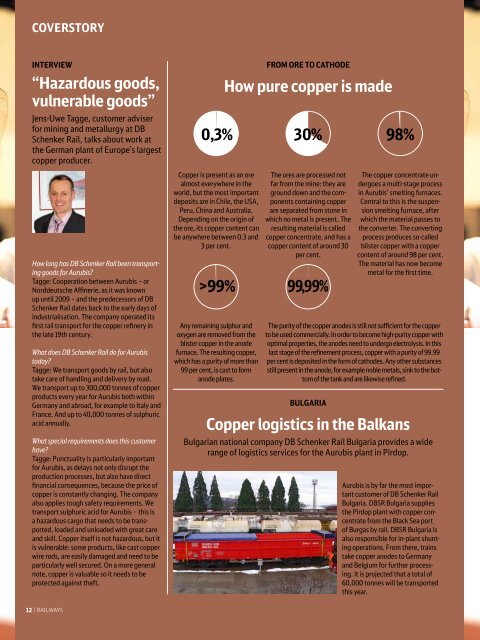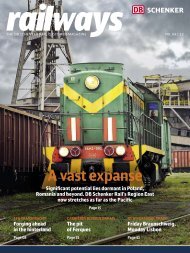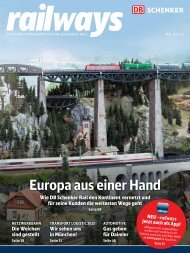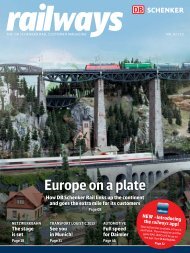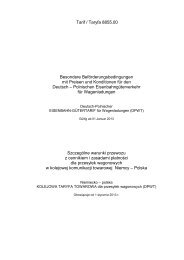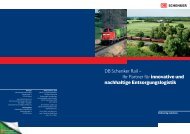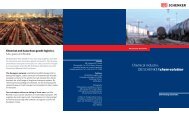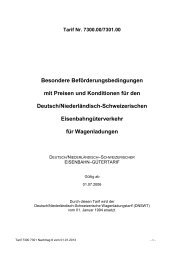PDF Download - DB Schenker Rail Deutschland AG
PDF Download - DB Schenker Rail Deutschland AG
PDF Download - DB Schenker Rail Deutschland AG
Create successful ePaper yourself
Turn your PDF publications into a flip-book with our unique Google optimized e-Paper software.
COVERSTORY<br />
INTERVIEW<br />
“Hazardous goods,<br />
vulnerable goods”<br />
Jens-Uwe Tagge, customer adviser<br />
for mining and metallurgy at <strong>DB</strong><br />
<strong>Schenker</strong> <strong>Rail</strong>, talks about work at<br />
the German plant of Europe’s largest<br />
copper producer.<br />
How long has <strong>DB</strong> <strong>Schenker</strong> <strong>Rail</strong> been transporting<br />
goods for Aurubis?<br />
Tagge: Cooperation between Aurubis – or<br />
Norddeutsche Affinerie, as it was known<br />
up until 2009 – and the predecessors of <strong>DB</strong><br />
<strong>Schenker</strong> <strong>Rail</strong> dates back to the early days of<br />
industrialisation. The company operated its<br />
first rail transport for the copper refinery in<br />
the late 19th century.<br />
What does <strong>DB</strong> <strong>Schenker</strong> <strong>Rail</strong> do for Aurubis<br />
today?<br />
Tagge: We transport goods by rail, but also<br />
take care of handling and delivery by road.<br />
We transport up to 300,000 tonnes of copper<br />
products every year for Aurubis both within<br />
Germany and abroad, for example to Italy and<br />
France. And up to 40,000 tonnes of sulphuric<br />
acid annually.<br />
What special requirements does this customer<br />
have?<br />
Tagge: Punctuality is particularly important<br />
for Aurubis, as delays not only disrupt the<br />
production processes, but also have direct<br />
financial consequences, because the price of<br />
copper is constantly changing. The company<br />
also applies tough safety requirements. We<br />
transport sulphuric acid for Aurubis – this is<br />
a hazardous cargo that needs to be transported,<br />
loaded and unloaded with great care<br />
and skill. Copper itself is not hazardous, but it<br />
is vulnerable: some products, like cast copper<br />
wire rods, are easily damaged and need to be<br />
particularly well secured. On a more general<br />
note, copper is valuable so it needs to be<br />
protected against theft.<br />
12 | <strong>Rail</strong>ways<br />
0,5%<br />
0,3% 30% 98%<br />
Copper is present as an ore<br />
almost everywhere in the<br />
world, but the most important<br />
deposits are in Chile, the USA,<br />
Peru, China and Australia.<br />
Depending on the origin of<br />
the ore, its copper content can<br />
be anywhere between 0.3 and<br />
3 per cent.<br />
>99%<br />
Any remaining sulphur and<br />
oxygen are removed from the<br />
blister copper in the anode<br />
furnace. The resulting copper,<br />
which has a purity of more than<br />
99 per cent, is cast to form<br />
anode plates.<br />
FROM ORE TO CATHODE<br />
How pure copper is made<br />
The ores are processed not<br />
far from the mine: they are<br />
ground down and the components<br />
containing copper<br />
are separated from stone in<br />
which no metal is present. The<br />
resulting material is called<br />
copper concentrate, and has a<br />
copper content of around 30<br />
per cent.<br />
99,99%<br />
The purity of the copper anodes is still not sufficient for the copper<br />
to be used commercially. In order to become high-purity copper with<br />
optimal properties, the anodes need to undergo electrolysis. In this<br />
last stage of the refinement process, copper with a purity of 99.99<br />
per cent is deposited in the form of cathodes. Any other substances<br />
still present in the anode, for example noble metals, sink to the bottom<br />
of the tank and are likewise refined.<br />
BULGARIA<br />
The copper concentrate undergoes<br />
a multi-stage process<br />
in Aurubis’ smelting furnaces.<br />
Central to this is the suspension<br />
smelting furnace, after<br />
which the material passes to<br />
the converter. The converting<br />
process produces so-called<br />
blister copper with a copper<br />
content of around 98 per cent.<br />
The material has now become<br />
metal for the first time.<br />
Copper logistics in the Balkans<br />
Bulgarian national company <strong>DB</strong> <strong>Schenker</strong> <strong>Rail</strong> Bulgaria provides a wide<br />
range of logistics services for the Aurubis plant in Pirdop.<br />
Aurubis is by far the most important<br />
customer of <strong>DB</strong> <strong>Schenker</strong> <strong>Rail</strong><br />
Bulgaria. <strong>DB</strong>SR Bulgaria supplies<br />
the Pirdop plant with copper concentrate<br />
from the Black Sea port<br />
of Burgas by rail. <strong>DB</strong>SR Bulgaria is<br />
also responsible for in-plant shunting<br />
operations. From there, trains<br />
take copper anodes to Germany<br />
and Belgium for further processing.<br />
It is projected that a total of<br />
60,000 tonnes will be transported<br />
this year.


